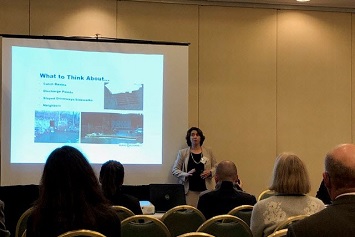At the Connecticut Business and Industry Association’s (CBIA) 2018 Energy and Environment Conference, a panel of industry experts recommended several best practices and business strategies that companies should consider as part of their spill response preparation process beyond the mandatory Spill Prevention, Control, and Countermeasure (SPCC) requirements.

Speaking to a room of business professionals, attorneys Rachel Rosen and Richard Fil and commercial and environmental insurance specialist Vincent Falcigno advocated a multifaceted approach to spill prevention and response that encompasses practical considerations, calculated business and legal strategies, and informed commercial insurance choices in order to manage risks, limit impacts, and improve community and government relations.
Practical Matters
Rosen, of Burns & McDonnell, kicked off the presentation with a discussion of practical considerations that are vital to effective spill response but that frequently get overlooked by companies both large and small. By having the foresight to manage variables not regulated by the SPCC rules, businesses can increase efficiency, reduce confusion during a crisis, and minimize the monetary and legal consequences of potential spills. Her recommendations for attendees included:
- Periodically confirm relationships with on-call spill response contractors, the local fire department, and any environmental consultants or attorneys being retained before a spill event occurs to improve response time.
- Know your reporting requirements beyond those mandated by federal and state requirements, such as obligations to inform corporate entities, insurance companies, landlords, lenders, or parent companies.
- Create and post a one-page laminated guide for employees that lists emergency contacts, alternates, spill response assignments, and actions to take in the event of a spill.
- Plan for releases from sources not covered in an SPCC plan, such as equipment that does not routinely contain oil (e.g., chillers, circulators, pumps, relief valves, and secondary containment), delivery trucks, and sabotage.
- Use dedicated equipment when responding to and documenting a spill, such as a camera instead of a personal cell phone or designated field notebooks, to minimize the consequences and inconveniences of a subpoena in the aftermath of a spill.
- Quantify and record the amounts of product released and recovered—some agencies may reduce fines if enough product is successfully recovered.
Protecting Your Image and Your Bottom Line
Fil, of Robinson + Cole, then turned the discussion to smart legal and business strategies to implement, though not required in an SPCC plan, focusing primarily on effective communication in the wake of a spill.
In order to promote business continuity, improve community and government relationships, and enhance response efforts, Fil emphasized the importance of creating a strategic communications process as part of a company’s spill response plan. By preparing a skilled spokesperson and refining the procedures for “how the boots will notify the suits” about cleanup efforts before a spill crisis occurs, businesses can avoid miscommunication and reactive responses and tailor their message to their audience’s priorities. If companies include communications drills with the rest of their spill response preparation, they can also anticipate how to tactfully address potential angry neighbors, disgruntled employees, politicians, and protestors.
In addition to creating strong communication channels, Fil also recommended that businesses protect their attorney and consultant communications, preserve evidence and scene information, prepare for and manage subsequent inspections by agencies and insurers, and keep in mind their future positioning as a plaintiff or defendant in any subsequent lawsuits.

Are You Covered?
To address one of the most important yet commonly overlooked aspects of spill response preparation, Falcigno, of the Gowrie Group, concluded the presentation with a discussion of the insurance options available for spills and other pollution-related events. Many businesses do not have the appropriate coverage and will face significant financial hardship unless they do their due diligence.
Environmental impairment liability (EIL) policies are available for companies that may be involved in pollution events, but they are nonstandard and site-specific. These companies should evaluate the types of coverage they may need, including for bodily injury, property damage, remediation costs, new pollution conditions, and/or preexisting pollution conditions. They should also be aware of policies’ terms and conditions, especially what are and are not included as covered remediation expenses, exclusions, conditions, and settlement provisions. Additionally, businesses may also be able to obtain coverage for emergency response costs, which is now available from some insurance companies.
The Takeaways
Ultimately, companies with the potential to have an oil spill event should be mindful of their business interests beyond the minimum required by federal and state regulations. The panelists agreed that with strategic and thorough preparation, the worst legal and financial impacts can be mitigated and business continuity preserved.
